Introduction
Shoulder impingement is one of the most common causes of shoulder pain. It occurs when the rotator cuff tendons rub against the top of the shoulder blade (the acromion), resulting in irritation and inflammation. This typically begins with mild discomfort, but over time, it can progress to weakness, limited mobility, and persistent pain in the front or side of the shoulder. Many people describe it as a sharp pinch when they raise their arms overhead traps.
You might notice pain when reaching behind your back, lifting objects, or even while sleeping on your side. Some people experience right scapular pain or a dull ache that spreads down the arm. Doing targeted Shoulder Impingement Exercises can help relieve this discomfort, but it’s important to know the key difference between shoulder impingement and a rotator cuff tear: impingement is irritation, while a tear is actual tendon damage.
Athletes often face this issue, especially swimmers and throwers—hence the term “swimmer’s shoulder.” Women going through hormonal changes, like menopause, frozen shoulder, are also at higher risk due to joint stiffness and reduced elasticity of soft tissues.
The good news? In most cases, shoulder impingement exercises are the first and most effective line of treatment. They not only reduce pain but also restore mobility and prevent further injury. Instead of relying only on medication, exercises strengthen the supporting muscles, improve posture, and create long-term relief.
Table of Contents
The Role of Exercises in Shoulder Impingement Treatment
Shoulder impingement can feel frustrating. The sharp pinch when you raise your arm or the dull ache that lingers afterward often makes daily activities a struggle. For complete recovery, pairing exercises with the right Protein Powders can also support muscle repair and healing.
When tendons are irritated, the surrounding muscles must be strengthened to reduce the pressure on them. Shoulder impingement exercises work by improving the balance between the rotator cuff muscles, the scapula stabilizers, and the larger movers like the deltoids. If one group is weak, the others take over, leading to faulty movement and more pain. By restoring balance, exercises reduce the pinching effect inside the joint.
Another important benefit is mobility restoration. When pain sets in, people tend to stop moving their shoulders fully. This leads to stiffness, frozen shoulder, or even muscle wasting over time. Simple mobility drills like pendulum swings or wall slides ensure that your shoulder range of motion (ROM) stays intact while you heal.
Exercises also help improve posture. Rounded shoulders and forward head posture are common causes of internally rotating shoulders, which worsen impingement. Strengthening the back muscles and stretching the front muscles helps pull your shoulders into a healthier alignment. Over time, this relieves stress on the tendons.
In addition, exercises provide a safe and natural alternative to long-term painkillers. While shoulder impingement medication can reduce symptoms temporarily, it doesn’t solve the root problem. Physical therapy, stretches, and strengthening movements address the actual mechanics behind the pain.
Finally, exercises are essential for prevention. Once you’ve had shoulder impingement, you’re more likely to get it again if you don’t maintain strength and flexibility. A regular routine of shoulder impingement stretches and shoulder impingement exercises helps protect your shoulders for life.
Warm-Up & Mobility Before Rehab Exercises
Before jumping into strengthening routines, your shoulders need to be prepared. A cold, stiff joint is more likely to flare up and make pain worse. That’s why shoulder warm-up and mobility exercises are the first step in any shoulder impingement treatment plan. Think of them as priming the engine before a long drive.
A warm-up increases blood flow, relaxes tight muscles, and makes the tendons more elastic. This means less friction inside the joint and a lower chance of irritation. For people with shoulder impingement syndrome, even 5–10 minutes of gentle movement can make the difference between safe progress and a setback.
Simple Warm-Up Ideas
- Arm swings forward and back – Stand tall and swing each arm in a relaxed motion, front to back, 10–15 times.
- Arm swings side to side – Cross your arms gently across your chest and open wide again. This loosens the chest and back muscles streches.
- Shoulder circles – Roll your shoulders slowly forward and backward, about 10 times each direction.
- Wall slides – Stand with your back against a wall. Raise your arms like a goalpost and slide them upward as far as comfortable, then back down. This activates the scapular muscles and promotes healthy shoulder mechanics.
These movements are especially helpful for anyone experiencing pain in the front of the shoulder or right scapular pain, because they gently reintroduce motion without heavy loading.
Shoulder ROM (Range of Motion) Drills
Maintaining motion is crucial in shoulder rehab exercises. Stiffness makes impingement worse, so gentle shoulder ROM exercises should be part of your daily routine. The classic pendulum exercise is perfect here: lean forward with one hand on a table for support, and let your other arm dangle freely. Swing it in small circles, forward-backward, and side-to-side. This relaxes the joint capsule while improving circulation to the tendons.
Pain Monitoring Scale
Not all discomfort is bad. When doing warm-ups, aim to keep your pain between 0–3 out of 10 (mild discomfort is okay). If it rises above 5 out of 10, stop and modify the movement. This helps you progress safely without making the irritation worse.
Why Warm-Ups Matter for Shoulder Impingement
Skipping warm-ups can cause the rotator cuff and surrounding tendons to tighten further, leading to more pinching during overhead movement. On the other hand, daily mobility drills combined with stretching keep your shoulder external rotation and internal rotation smooth and pain-free. Over time, this reduces the need for medications and speeds up recovery.
Strengthening Exercises for Shoulder Stability
Once you’ve warmed up and stretched the shoulder, the next step is building strength. Weak muscles around the shoulder joint are one of the main reasons shoulder impingement syndrome develops in the first place. The rotator cuff, scapular stabilizers, and upper back muscles all need to work together to keep the humeral head (upper arm bone) centered in its socket. If these muscles aren’t strong, the tendons can get pinched more easily.
The goal of strengthening isn’t just to get bigger muscles. It’s to restore balance, stability and control. With the right shoulder strengthening exercises, you’ll improve posture, reduce the load on irritated tendons, and prevent future injuries.
1. Resistance Band External Rotation
This is one of the most prescribed physical therapy Shoulder Impingement Exercises. Anchor a resistance band to a doorknob or sturdy object. Keep your elbow bent at 90 degrees and tucked into your side. Rotate your hand outward, away from your body, while keeping the elbow in place.
2. Resistance Band Internal Rotation
Anchor the band again, but this time stand so the band pulls outward. Keep the elbow bent at 90 degrees, tucked into your side, and rotate your hand across your stomach. This move strengthens the subscapularis, which balances the external rotators. Restoring this balance is critical for fixing internally rotating shoulder posture.
3. Standing Row with Band
Tie a resistance band around a stable object and hold each end. Pull your elbows back, keeping them close to your sides, while squeezing your shoulder blades together. This activates the middle trapezius and rhomboids, which help stabilize the shoulder blades. Strong scapular control is one of the best ways to prevent impingement from returning.
4. Scapula Setting and Retraction
Lie on your stomach with your arms by your sides. Draw your shoulder blades down and back, hold for 5–10 seconds, then relax. This simple movement builds awareness of scapular positioning and helps maintain healthy posture during all other exercises.
5. Trapezius Strengthening (Y-Raise)
Lie face down on a bench or stability ball. With light weights or no weight at all, raise your arms in a Y-shape until they’re at shoulder height. Slowly lower. This strengthens the lower trapezius, which often becomes weak in people with shoulder pain.
Tips for Safe Strength Training
- Begin with bands or light dumbbells (1–3 kg is plenty).
- Do 2–3 sets of 10–15 reps for each movement.
- Focus on slow, controlled motion, not heavy weights.
- Avoid jerky overhead lifting until your mobility and strength improve.
Shoulder Impingement Exercises with Weights
After regaining mobility and building a foundation with band exercises, the next step is introducing weights. Many people with shoulder impingement fear lifting, but when done correctly, free weight Shoulder Impingement Exercises can help strengthen weak muscles, restore balance, and protect the joint. The key is to choose the right moves, maintain perfect form, and progress gradually.
1. Seated Dumbbell Press (Modified)
Sit upright with your back supported. Hold a dumbbell in each hand at shoulder level. Press them upward slowly, stopping just before any pinching pain. Lower with control. Avoid locking the elbows or arching the back. This version removes lower-body momentum, isolating the shoulders safely.
Sets/Reps: 2–3 sets of 8–10 reps with light weight.
2. Arnold Press (Controlled Range)
Popularized by Arnold Schwarzenegger, this variation adds a rotation. Start with dumbbells in front of your chest, palms facing you. As you press up, rotate your palms outward. Lower back to start. For people with impingement, keep the motion slow and stop if sharp pain appears. This move activates the front and side delts while encouraging external rotation.
Sets/Reps: 2–3 sets of 8–12 reps.
3. Reverse Fly
Stand bent forward at the hips, holding light dumbbells with palms facing each other. With a slight bend in your elbows, raise your arms out to the sides until they are shoulder height. Focus on squeezing your shoulder blades. This strengthens the rear delts, rhomboids, and middle trapezius—muscles that counteract rounded shoulder posture and reduce impingement risk.
Sets/Reps: 3 sets of 10–12 reps.
4. Plank Dumbbell Shoulder Raise
Start in a plank position with dumbbells under your hands. Lift one arm forward, keeping your body stable, then return and switch sides. This combines core stability with shoulder activation. It’s excellent for advanced rehab once pain has reduced.
Sets/Reps: 2 sets of 6–8 raises per side.
5. Front Raise (Low Weight Only)
Hold dumbbells in front of your thighs. With a slight bend in your elbows, raise one or both arms forward to shoulder level. Lower slowly. Keep weights light to avoid stress on the front shoulder tendons, which are often irritated in shoulder impingement syndrome.
Sets/Reps: 2–3 sets of 10 reps.
Safety Tips When Using Weights
- Start with very light dumbbells (1–3 kg).
- Avoid upright rows with a narrow grip, as they worsen impingement.
- Maintain a scapula setting (gently squeeze the shoulder blades) during every lift.
- Stop immediately if the pain is sharp or increases to more than 3–4/10.
- Always follow weights with gentle shoulder impingement stretches to release tightness.
Shoulder Strengthening & Resistance Band Exercises
Strengthening the rotator cuff and surrounding muscles is the core treatment for shoulder impingement syndrome. When the shoulder stabilizers are weak, the humeral head rides upward and pinches the tendons, leading to pain. By performing controlled resistance band shoulder exercises, you retrain these muscles to support and protect the joint.
1. Band External Rotation
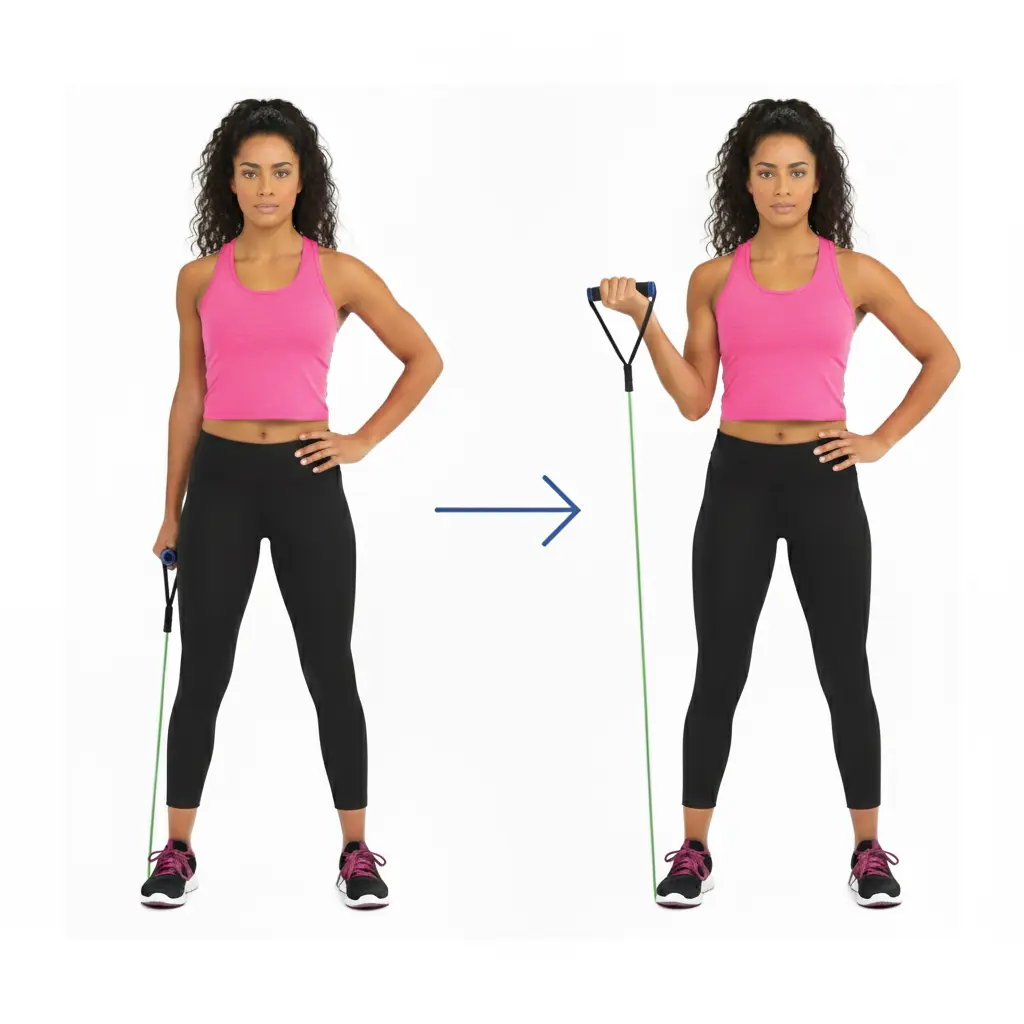
Anchor a resistance band to a doorknob. Hold it with your elbow bent at 90° and tucked to your side. Slowly rotate your forearm outward, then return with control. This targets the infraspinatus and teres minor, crucial for preventing impingement.
Sets/Reps: 3 sets of 10–12 reps per side.
2. Band Internal Rotation
Using the same setup, turn and pull the band across your body. This works the subscapularis and chest muscles, balancing external rotation strength.
Sets/Reps: 3 sets of 10–12 reps.
3. Scapular Retraction (Band Rows)
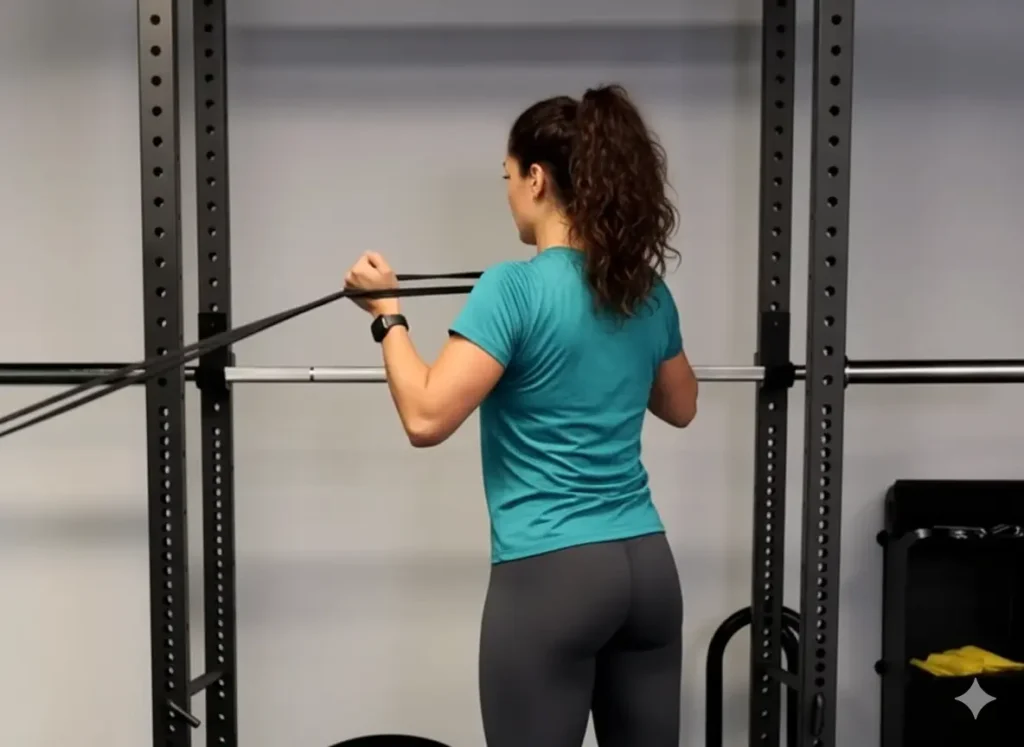
Attach the band at chest height. Pull it straight back while squeezing your shoulder blades together. This strengthens the rhomboids and middle trapezius, correcting posture that contributes to impingement.
Sets/Reps: 3 sets of 12–15 reps.
4. Wall Slide with Band
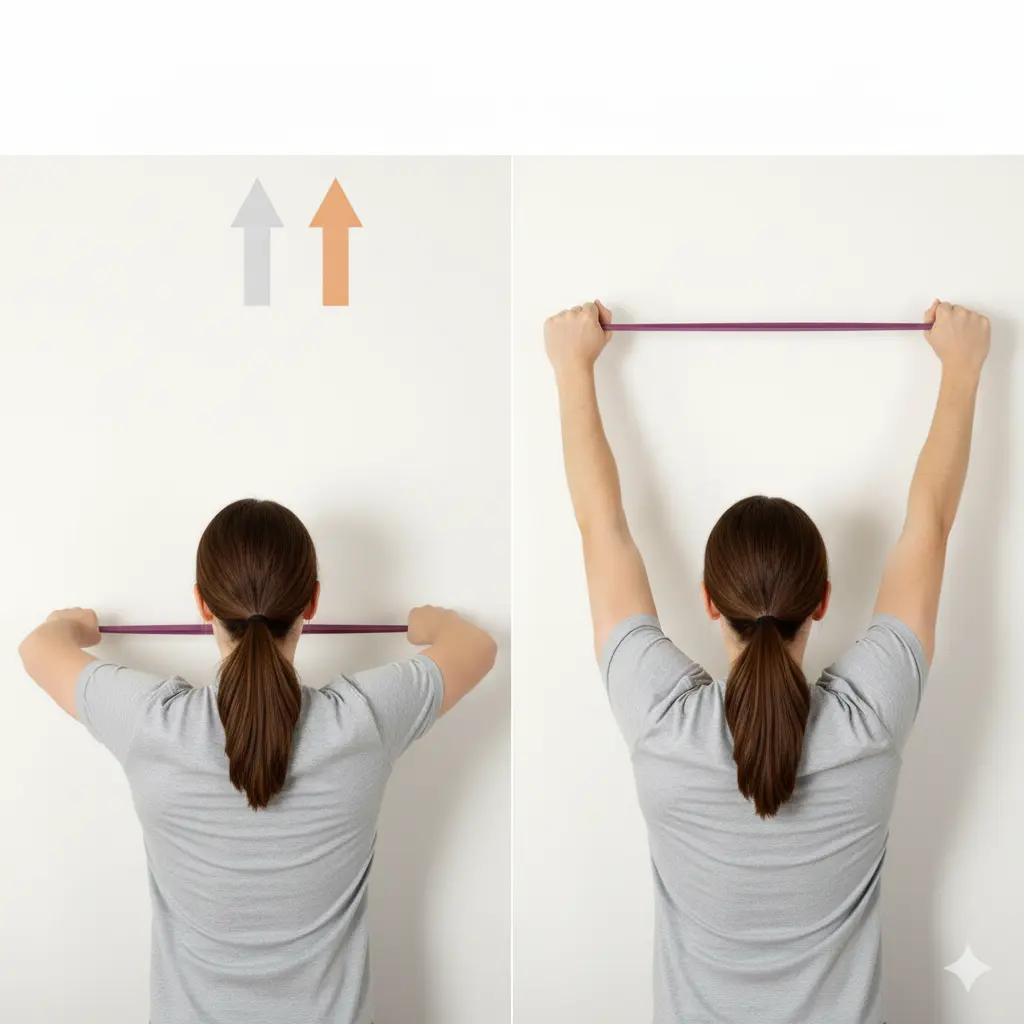
Loop a light band around your wrists. Stand with your back to the wall and slowly slide your arms upward while keeping tension on the band. This improves scapular upward rotation, vital for overhead mobility.
Sets/Reps: 2–3 sets of 8–10 slow reps.
5. Face Pulls with Band
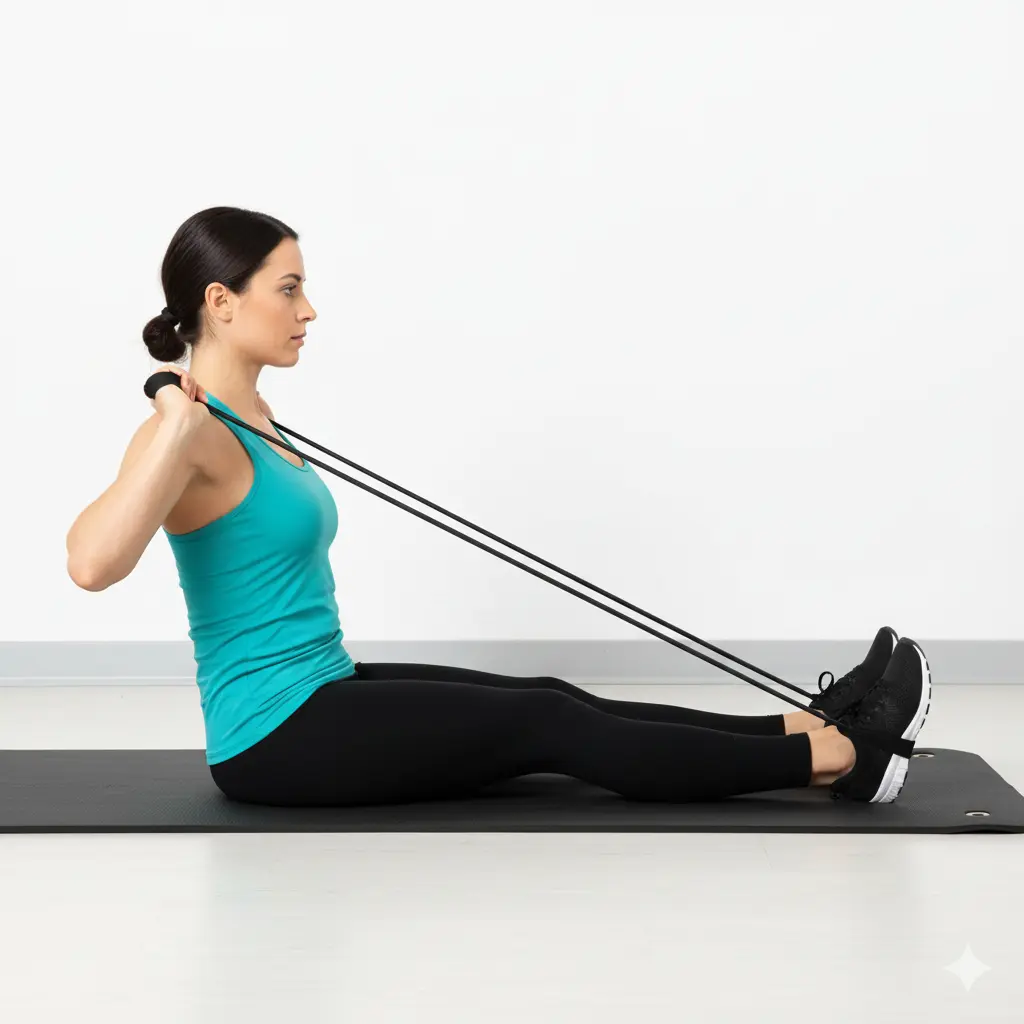
Anchor the band at eye level. Pull it toward your face with elbows high and wide, focusing on the rear delts and lower traps. This exercise restores balance and prevents rounded shoulder posture.
Sets/Reps: 3 sets of 10–12 reps.
6. Resistance Band Front Raise (Low Intensity)
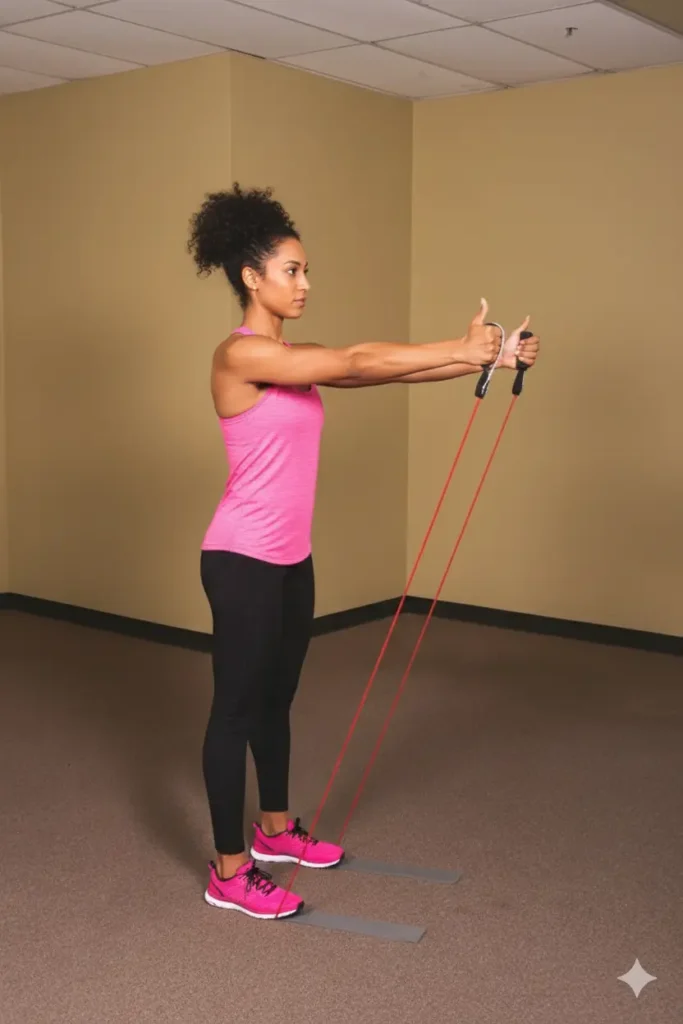
Hold the band under your feet and lift your arms forward to shoulder level. This lightly strengthens the anterior deltoid without overloading it, which is important for people with shoulder tendonitis.
Sets/Reps: 2–3 sets of 8–10 reps.
Why Bands Work Best for Shoulder Impingement
- Provide variable resistance that’s easier on the joints than heavy weights.
- Allow safe progression from rehab to strengthening.
- Encourage slow, controlled movement, reducing the risk of flare-ups.
- Can be used anywhere, making them ideal for shoulder impingement self-care.
How to Fix & Prevent Shoulder Impingement (Self-Care & Lifestyle Tips)
Treating shoulder impingement isn’t just about exercises—it’s about how you move, rest, and care for your shoulders daily. A strong self-care routine can speed up recovery and reduce the chances of recurring pain.
1. Listen to Your Pain Levels
Pain is your body’s signal. Mild discomfort (rated 2–3/10) during exercise can be normal, but sharp or worsening pain means you need to stop. Always progress gradually and allow your body to adapt.
2. Modify Daily Activities
- Avoid repetitive overhead reaching (like painting or stocking shelves).
- Don’t carry heavy bags on one shoulder—use both straps.
- Keep workstations ergonomic: screens at eye level, chairs supportive, and arms close to the body while typing.
3. Apply Heat and Ice Wisely
- Ice: Use after workouts or flare-ups to calm inflammation.
- Heat: Use before stretching or in the morning to relax stiff muscles.
4. Prioritize Posture
Poor posture is one of the main causes of shoulder impingement. Practice scapula setting (gently squeezing shoulder blades down and back) during work, exercise, and even standing. This opens space in the shoulder joint and reduces tendon pinching.
5. Regular Mobility Work
Include shoulder impingement stretches like pendulums, doorway pec stretches, and crossover arm stretches in your daily routine. Even 5 minutes twice a day can maintain a range of motion.
6. Strengthen the Rotator Cuff and Scapula
Consistent use of shoulder PT exercises such as external rotations, band rows, and wall slides builds long-term protection. Strong stabilizers mean less chance of injury when lifting or playing sports.
7. Gradual Return to Sports & Workouts
If you’re an athlete or gym-goer, don’t rush back to heavy pressing or overhead moves. Start with light resistance training and progress to full workouts over weeks.
8. Maintain Shoulder Health Long-Term
Even after recovery, continue:
- Shoulder warm-up drills before any workout.
- Back and rotator cuff strengthening at least twice a week.
- Stretching after training to prevent tightness.
Special Cases: Swimmer’s Shoulder, Frozen Shoulder, and Shoulder Tendonitis
While general shoulder impingement exercises work for most people, certain conditions need specific care. Understanding these cases helps you apply the right mix of stretches, strengthening, and therapy.
1. Swimmer’s Shoulder
Also known as shoulder impingement in athletes, swimmer’s shoulder occurs due to repeated overhead strokes. The constant rotation and elevation of the arm narrow the subacromial space, irritating the rotator cuff.
Best Exercises:
- Band External Rotation – balances overuse of internal rotators.
- Scapular Stabilization Drills – face pulls and wall slides improve posture in the water.
- Thoracic Spine Mobility Drills – open up the chest and back for smoother arm recovery.
2. Frozen Shoulder (Adhesive Capsulitis)
This condition involves stiffness and restricted ROM rather than tendon pinching. It often occurs in women over 40, especially during menopause. Progression goes through three stages: freezing, frozen, and thawing.
Best Approach:
- Gentle pendulum swings and table slides to maintain mobility.
- Heat therapy before stretching to ease tightness.
- Patience—frozen shoulder can take months to resolve, and forcing motion can worsen pain.
3. Shoulder Tendonitis
Inflammation of the rotator cuff or biceps tendon is common in weightlifters, manual workers, and athletes. It overlaps with shoulder impingement syndrome, but pain is often sharper at the front of the shoulder.
Best Exercises:
- Isometric Holds – pressing against a wall without moving builds strength without stressing inflamed tendons.
- Resistance Band Rows – strengthen the upper back, reducing load on the front.
- Rotator Cuff Strengthening – light external and internal rotations to restore tendon health.
Shoulder Rehab Workouts & Step-by-Step Routines
A structured program makes recovery smoother. Below are sample routines you can follow depending on your stage: early rehab, strengthening, or return to full activity. Always adjust based on pain levels and progress gradually.
Phase 1: Early Rehab (Pain Relief & Mobility)
Goal: Reduce irritation, improve range of motion (ROM).
Frequency: Daily
- Pendulum Swing – 2 sets, 30–60 seconds
- Crossover Arm Stretch – Hold 20–30 seconds, 3 reps per side
- Doorway Pec Stretch – Hold 20 seconds, 3 reps
- Sleeper Stretch – Hold 20–30 seconds, 3 reps
Focus on gentle mobility. Stop if sharp pain occurs.
Phase 2: Basic Strengthening (Rotator Cuff & Scapula
Goal: Build foundational strength in the rotator cuff and stabilizers.
Frequency: 3–4 times per week
- Band External Rotation – 3 sets of 10–12 reps
- Band Internal Rotation – 3 sets of 10–12 reps
- Scapular Retraction (Band Rows) – 3 sets of 12–15 reps
- Wall Slide Mobility Drill – 2 sets of 8–10 slow reps
These shoulder PT exercises help rebalance the joint and improve posture.
Phase 3: Weighted Shoulder Impingement Workout
Goal: Transition to controlled strength with light weights.
Frequency: 2–3 times per week
- Seated Dumbbell Press (light) – 2–3 sets of 8 reps
- Reverse Fly (light dumbbells) – 3 sets of 10 reps
- Arnold Press (controlled motion) – 2 sets of 10 reps
- Front Raise (light) – 2 sets of 8–10 reps
- Plank Dumbbell Shoulder Raise – 2 sets of 6 per side
Keep weights low; focus on form, control, and stability.
Phase 4: Advanced Stability & Return to Spor
Goal: Combine strength, mobility, and stability for long-term shoulder health.
Frequency: 2–3 times per week
- Landmine Press – 3 sets of 8 reps
- Face Pull to External Rotation (band/cable) – 3 sets of 10 reps.
- Overhead Carry (light kettlebells) – Walk 20–30 seconds, repeat 3 times
- Push-Up Plus – 3 sets of 8–12 reps
- Quadruped Y-T-W Holds – 2 sets, 5 reps in each position
This phase ensures you not only fix shoulder impingement but also prevent recurrence.
FAQs(Frequently Asked Question)
Q1. How do I know if I have shoulder impingement?
If you feel pain when lifting your arm overhead or reaching behind your back, you may have impingement. A doctor or physical therapist can confirm.
Q2. What are the best exercises for shoulder impingement?
Pendulum swings, band rotations, scapular retractions, and sleeper stretches are the most effective.
Q3. Can I lift weights with shoulder impingement?
Yes, but only with light weights and controlled form. Avoid upright rows and heavy overhead presses.
Q4. How long does recovery take?
Most mild cases improve in 4–6 weeks. Severe cases may take 3–6 months with consistent rehab.
Q5. Should I use heat or ice?
Use ice after exercise to reduce inflammation and heat before stretching to loosen muscles.
Conclusion
Shoulder exercises can limit your strength, flexibility, and confidence in daily movement. The good news is that most cases improve without surgery when you follow a structured program of shoulder impingement exercises, stretches, and physical therapy. Starting with gentle mobility drills like pendulum swings, progressing to band rotations and scapular strengthening, and later adding controlled weight training ensures steady recovery.
At the same time, posture correction, self-care strategies, and consistent warm-ups are just as important as the exercises themselves. Whether you’re managing swimmer’s shoulder, tendonitis, or frozen shoulder, the key is patience, consistency, and proper guidance. Remember—your shoulders aren’t just for lifting weights in the gym. They support everything from simple daily tasks to high-level sports performance.
And if your goal is also fat loss, our Gym Workouts for Women will guide you with the best routines. With regular practice, most people can return to pain-free movement, stronger workouts, and improved posture.
Don’t wait for pain to dictate your lifestyle. Start today with these shoulder impingement stretches and strengthening routines to protect your shoulders for the future. If symptoms persist, consult a physical therapist for personalized care.

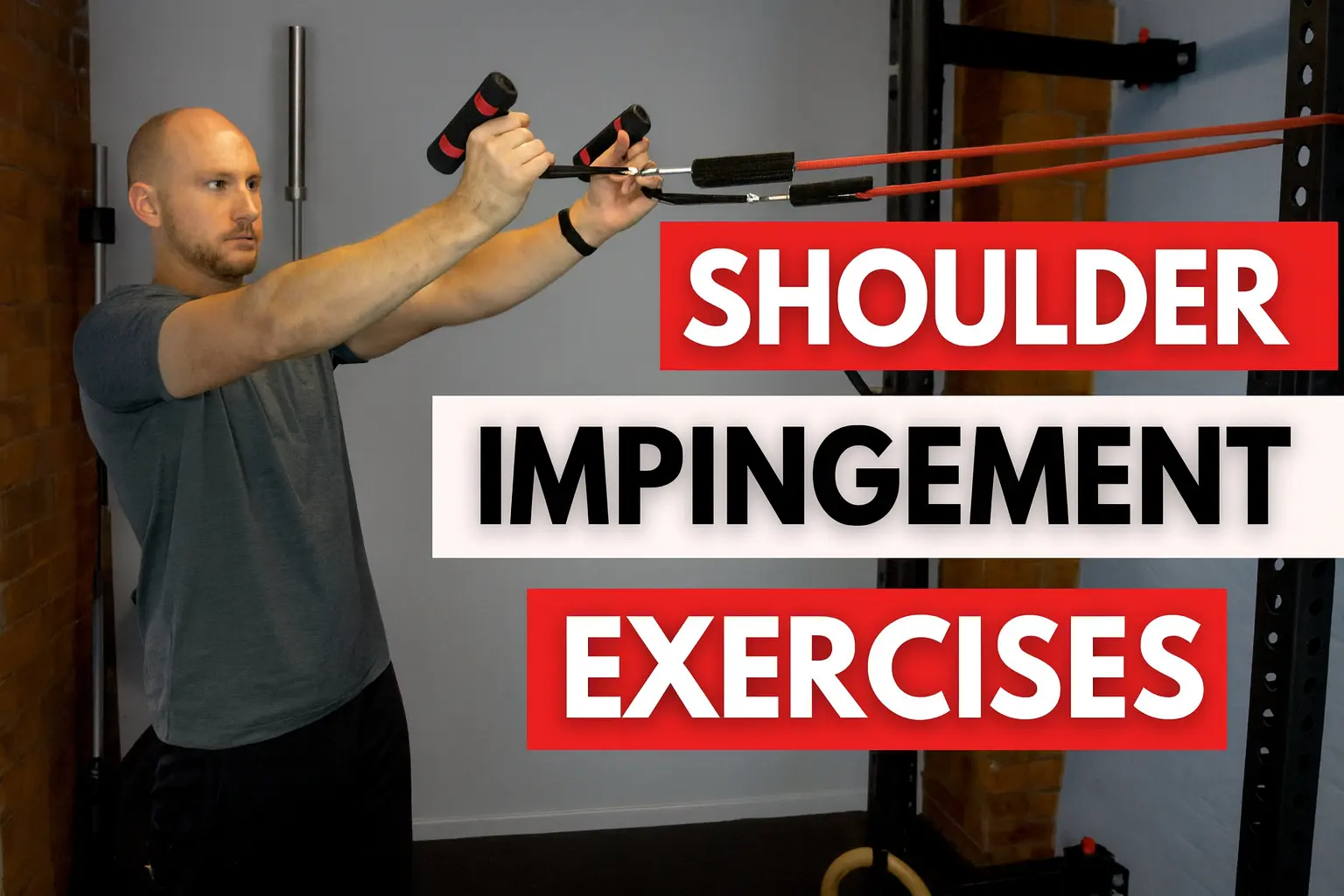
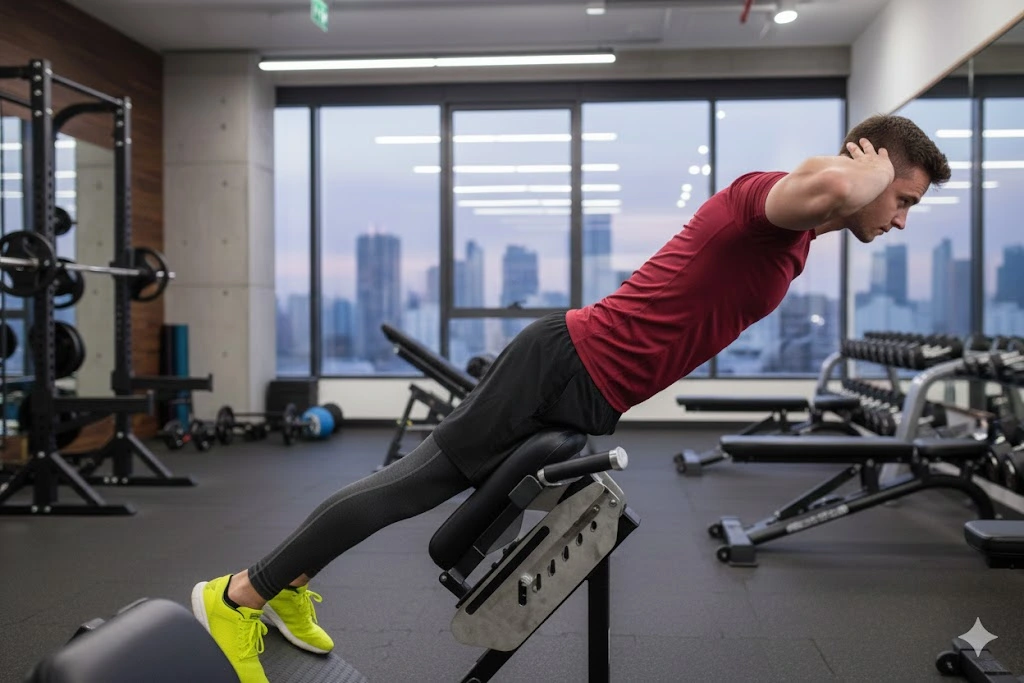



2 Responses
Hey very nice web site!! Man .. Beautiful .. Amazing .. I will bookmark your web site and take the feeds also…I am happy to find so many useful info here in the post, we need develop more techniques in this regard, thanks for sharing. . . . . .
very interesting subject , outstanding post.